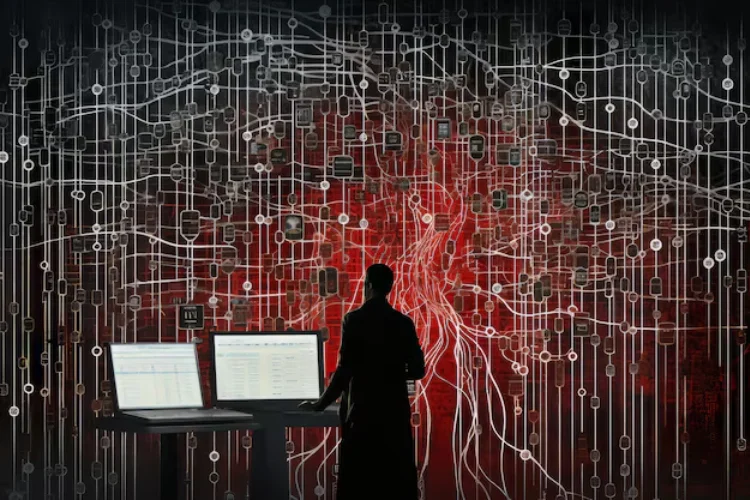IT Department Structure, Roles and Responsibilities
When you feel stuck in your task due to a technical glitch during the job, let the IT department handle it. They instantly resolve issues, helping you to resume work. Are you finding them halting your fun? However, they are the people who ensure all operations of an organization are functional.

- December 14, 2023
IT people act like superhumans in the working field. They appear when you call them for troubleshooting. Furthermore, many people in an organization worry about work stoppage. IT people play a significant role in killing the frustration of workaholic people by offering instant solutions. At the same time, the IT department ensures each employee possesses the essential tools to work properly.
IT Department for all Businesses
Table of Contents
IT department tasks are not only limited to fixing organizations’ IT-related issues but also maintaining the complete IT structure. They ensure the optimal information flow. The availability of an IT department is essential for all kinds of businesses, from corporate IT to a nonprofit organization.
Why Does the Structure of an IT Matter?
For the clarity of job roles, structuring an IT department is important in an organization. This enhances work efficiency and business workflow. Furthermore, structuring enables professionals to set a chain of command. IT department hierarchy makes everyone aware of their position and where and when they need to report. Execution of routine tasks with a proper IT department structure optimizes resource usage, enhances collaboration, and saves time.
How Should Businesses Set IT Department Hierarchy?
The method of setting up the IT department hierarchy varies from one business to another. Organizations analyze their business’s unique needs and establish an IT department hierarchy. For example, an e-commerce company needs a robust IT support team structure to avoid disruptions in workflow. They optimize payment gateways, saving customers from waiting. They also manage security cameras using key strategies.
Conversely, a consulting firm will look for a strong IT support organization structure for data protection.
The size of a business also determines the structuring of IT departments and system maintenance tasks. Here is how it works:
- In IT start-ups or small businesses, IT members may handle multiple tasks, such as system maintenance and network security.
- Large organizations set a clear division of tasks. They hire separate teams for cybersecurity, network admin, and tech support.
- IT specialists often provide regular updates and quick fixes so that other departments can smoothly perform their daily operations.
- In larger organizations, the IT department functions with a dedicated focus on infrastructure monitoring. It includes data security and cloud services maintenance.
Key roles in an IT Department
Key roles in an IT department set a direction for managing a project that directly influences business operations. Let us discuss some key positions in an IT department that effectively perform IT duties. They enable other departments to achieve business objectives.Chief Information Officer (CIO)
The CIO is in the top rank of the IT department. This position oversees all IT department activities, from developing technology strategy to IT budgeting. Sensing the challenges of their organization, the CIO ensures the organization’s IT infrastructure supports business goals.IT Manager
IT managers implement IT policies and strategies and are responsible for properly functioning the IT department’s routine operations. They also check the performance of IT staff, evaluate efficiency, and resolve issues. The managers also coordinate with other departments to understand and fulfill technological needs. Furthermore, IT managers ensure compliance with industry standards and safeguard the organization’s information.Network Engineer
A network engineer within an organization designs and configure local area network (LANs) and other networking systems. This position ensures smoother connectivity between devices and efficient communication among staff. Implementing robust security measures such as encryption, firewalls and segmentations to protect data. Making network infrastructure operational and securing it at the same time.Cyber security specialist
A cybersecurity specialist within IT department structure protects an organization’s digital assets against cyber threats. This position ensures data integrity and confidentiality. Monitoring systems by regularly conducting vulnerability tests and risk assessments.IT Procurement Officer
IT procurement officer is responsible for procuring the organization’s IT-related products. They assess the company’s IT requirements and identify the potential vendors to buy services or products. Develops and maintains relationships with suppliers to ensure product availability at discounted prices. IT procurement officer also ensure the proper deployment of new technologies.Network Administrator
A network administrator in the IT department of an organization sets up hardware such as routers and firewalls. This position configures and manages the company’s network connectivity. To maintain the continuity of workflow, a network administrator diagnoses and resolves connectivity issues.System Administrator
The system administrator is responsible for managing and maintaining computer systems within an organization. This position ensures the proper functioning of servers and operating systems. Identify the problem within the server and report to higher authorities depending on their IT support organization structure.Technical support specialist
A technical support specialist is the first person to contact when anyone in an organization faces technical disruptions. Resolving technical issues and troubleshooting hardware to ensure smooth functioning of IT systems are the primary responsibilities of this position.Responsibilities of the IT Department
The IT department of an organization, such as Advanced IT, fulfills various responsibilities. From making robust security measurements to planning the future technology needs of an organization, the department takes care of everything. Let us discuss the key responsibilities of an IT department within an organization.
Hardware and software maintenance
For hardware and software maintenance IT department performs many tasks, including installation, configuration and updating systems. The IT department performs the following responsibilities to meet business needs.
- Mining all physical devices.
- Deployment of patches for system updates.
- System optimization
IT strategy and planning
The department in an organization defines the long-term approaches for using technology in an organization. Helping organizations to meet objectives and drive growth. Planning aims to:
- Improve customer experience.
- Enhancing operational efficiency.
- Stepping into new marketplaces.
System Integration
The IT department combines subsystems, applications, and other technologies to create a unified system. It conducts assessments before integration to save time when identifying technical requirements. To ensure compatibility and security, the IT department creates a detailed integration plan using the following methods:
- Choosing suitable tools
- Evaluation complexity
- Middleware solutions
- API gateways
- Cloud-based integration
Software management
From the selection of software for the use of an organization to maintenance, the IT department oversees all tasks regarding software management. The department acquires software solutions specially designed to meet the organization’s particular needs.
Cloud services management
IT department manages cloud-related tasks such as data transfer. The department ensures data integrity and minimizes downtime. Reducing overall business operations by optimal allocation of resources.
User account management
Managing the accounts of employees is one of the fundamental responsibilities of the IT department. IT professionals can set up role-based access to protect an organization’s sensitive data. Such functioning prevents unauthorized access and also helps the department in data maintenance.
Automation and system optimization
Identifying the repetitive tasks of an organization, such as appointment scheduling or accepting recurring payments. The IT department integrates automation tools to automate these tasks to improve work efficiency. Ensuring automated processes remain compatible with existing infrastructure.
Research and development
The IT department stays updated on emerging technologies in the industry. It conducts thorough research to ensure the organization’s routine functions align with industry trends. Furthermore, discovering new information and driving IT innovation and development are key aspects of research and growth.
Friendly Asked Questions
1. What does an IT department do
IT department maintains and manages the IT infrastructure of an organization. The department implements advanced storage solutions for data management. Preventing data loss, especially during system failure, and safeguarding from data breaches. IT professionals perform various responsibilities depending on the nature of an organization.
2. What are the Seven Main Functions of the IT Department?
Key 7 responsibilities include:
- Managing hardware and software.
- Ensuring data security.
- Maintaining network infrastructure.
- Overseeing cloud services.
- Handling system integration.
- Automating processes and optimizing systems.
- Supporting research and development.
3. What is the Structure of an IT Department?
The hierarchy of an IT department depends on the organizational structure. However, most organizations develop the following structure:
- Chief Information Officer (CIO)
- IT Manager
- Network Engineer
- Cyber security specialist
- IT procurement officer
- Network administrator
- System administrator
- Technical support specialist
4. How does the IT department manage cloud services?
The IT department chooses the best platform to fulfill the requirements of an organization. IT professionals set up cloud systems, ensuring they work smoothly. Protecting an organization’s data using different techniques such as encryption and firewalls. Fixing issues in time to avoid disruptions.
5. Why is structuring an IT department important for businesses?
The structure of the IT department within an organization is important to perform tasks in order. A proper hierarchy of positions makes everyone aware of job roles and duties. It enhances work productivity and efficiency and saves time.
Facing IT Challenges in Chicago?
Schedule a consultation with our expert team to get the help you need!
Related Articles

Essential Components of IT Infrastructure

What is Managed Services: Model and Structure


